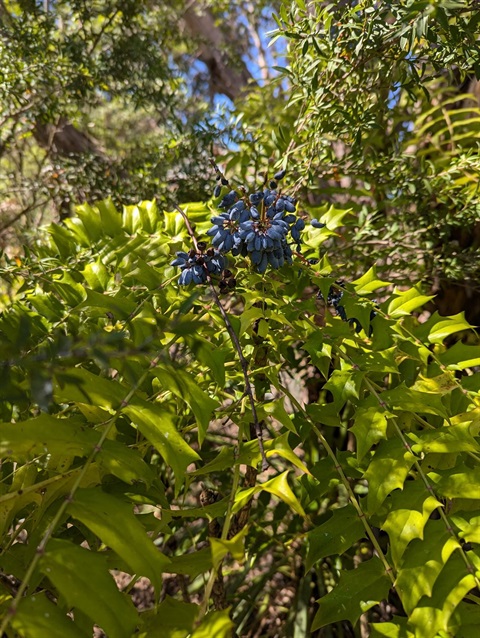
Gardens are a great source of peace, beauty, and fresh produce, offering both physical and mental nourishment, but they can also be the source of new weeds when the plants we cultivate escape into the surrounding environment. Many of our widespread weeds like cotoneaster and blackberry started off in gardens and around homesteads but their toughness, ability to spread easily, and lack of natural predators has allowed them to spread across farmland and natural areas where they can cause significant ecological and economic damage.
The Monaro region is already home to several naturalised garden escapees, but many more species could pose a threat if introduced, particularly given that many gardens are located near natural environments or agricultural land. One such example is Mahonia (Berberis oiwakensis, formerly Berberis lomariifolia).
While conducting routine weed inspections late last year, one of Council's biosecurity officers encountered an interesting but unfamiliar plant in a garden near Berridale. Further investigation, with samples sent to the NSW Herbarium, confirmed the plant's identity as Mahonia, an invasive species which had not been recorded previously in the south east region. Mahonia is a striking multi-stemmed tree which produces tall yellow flower spikes followed by berries which ripen to purplish-blue but its sharp, holly-like leaves are unpalatable to livestock and can cause injury to people.
Mahonia is a regional priority weed in the Hunter and north coast areas where it has been found invading forests and gullies. The source of these infestations is suspected to be deliberately introduced garden plants, highlighting the importance of responsible gardening practices to our local environment and economy.
There are a number of resources available to help people make better choices such as Gardening Responsibly, a website dedicated to helping people select plants that won't pose a threat to the environment. The site offers guidance on safe plant choices, provides lists of non-invasive alternatives, and offers practical tips for gardening in a way that supports local ecosystems. Particular care should be taken when purchasing plants or seed online as the unregulated nature of online sales increases the risk of unknowingly purchasing a high-risk species. By making informed plant choices, gardeners can contribute to preserving local biodiversity and preventing the spread of harmful species.
If you already have invasive plants in your garden, removing them and replacing them with less invasive alternatives is an important step in preventing further spread. When removing invasive species from your garden, proper green waste disposal is critical. Never dump garden clippings or cuttings, especially from invasive species, in local reserves or bushland as many of them can easily establish from cuttings or seed, creating new infestations. Green waste should always be disposed of properly in green waste bins or at a landfill or transfer station.






